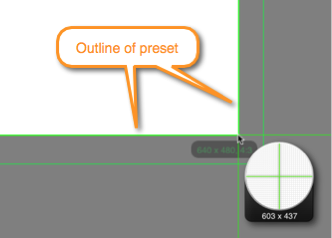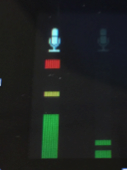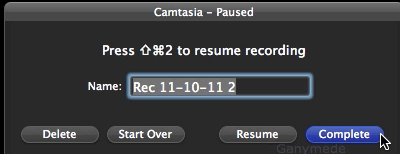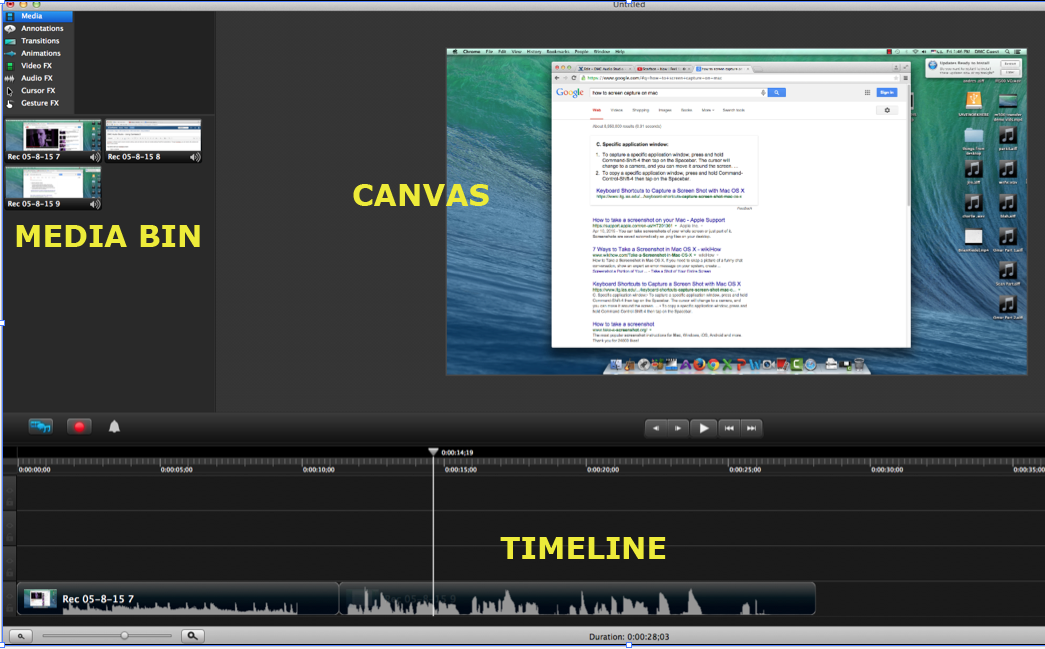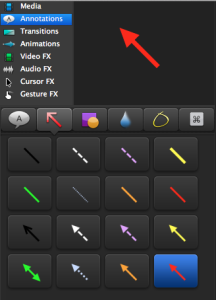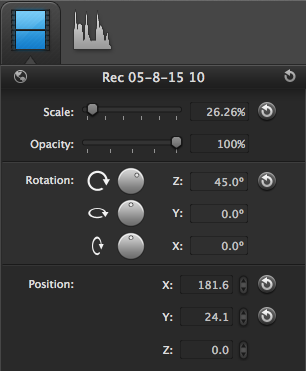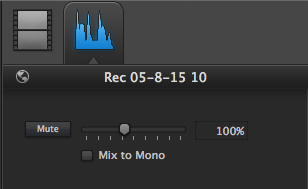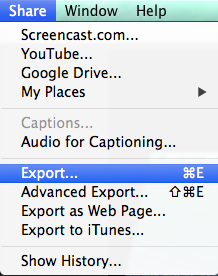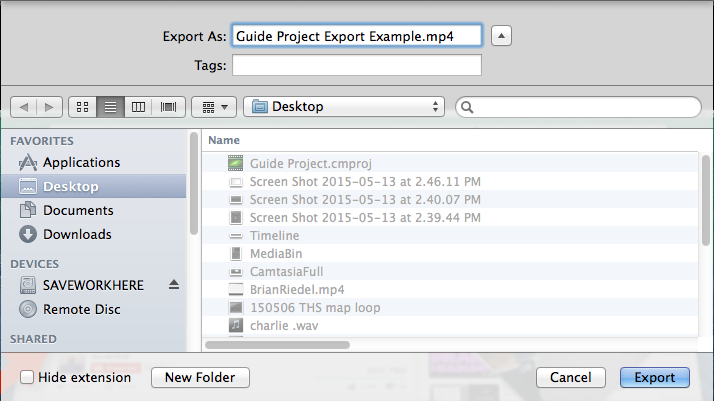Camtasia is software used to record onscreen activity, audio and web cam video and narrate existing PowerPoint presentations. Through Camtasia, you can record, edit, produce and share course content.
Tips before start your Camtasia project:
- Clean up desktop.
- Write a script or outline.
- Do a practice run through.
- Mic 1 is the default microphone and is always on. Mic 2 has an ON/OFF switch. ON is with the switch towards the head of the microphone. Be sure you check this before beginning your recording.
To Record:
- Launch Camtasia
- Close existing project or go to File > New Project
- Hit the Record button located on the middle toolbar
- The following window pops up:
- Select recording region:
- Record full screen. By default, Camtasia records the entire screen of your main monitor. Choose this option when your recording content includes:
A large or full-screen application or web browser.
Multiple applications or web browser windows.
Action that spans across the entire screen including the dock, application menus, etc
- Record using a preset when you want to share to a destination that requires specific dimensions such as YouTube, iPhone, or to embed on a website.
- Click on the triangle to the right and choose your desired region from the drop-down menu:
Recommended window size for 16:9 aspect ratio is either 1080pHD (1920x1080) or 720pHD (1280x720). A green outline appears indicating the capture area of selected window size.
- Record a custom region. Record a region of the screen when:
You only want to show a specific window or region of the screen, no extra content.
You need to record at specific dimensions.
You want to record at dimensions larger or smaller than one of Camtasia's presets, but still maintain the same aspect ratio of the preset.
- To set your own custom region, choose Custom Region, and click on the crosshairs that appear in place of the "rec" button .
- To select an area, click and drag on the screen. As you drag the cursor near a preset, an outline of the preset appears.
- To select a window, move the cursor over the window until a green border appears around the window. Click within the window to select that area.
You cannot access any applications or system settings while in the selection mode. Make sure to edit the audio settings, application or window position, and other system settings before selecting the area to record.
To cancel selection, click on back arrow or press Esc to edit these items .
- Record full screen. By default, Camtasia records the entire screen of your main monitor. Choose this option when your recording content includes:
- Select camera option: If you want to use the built-in iSight camera to record yourself, click on Camera to turn it on. A preview of the camera appears. Once you begin to record, the preview will disappear, but will become visible again in the editing stage.
- Select audio:
- From the Audio menu, be sure to select Duet USB - NOT Built-in Microphone, as you want to record with the desktop microphones with Duet audio interface.
- To adjust the audio input level, speak into the mic at the level you are wishing to record at. At the same time, observe the audio meter on the Duet Apogee interface; Press down the wheel repeatedly to toggle between the 2 different inputs, headphones and speaker level. Adjust the Mic input level (either Input 1 or Input 2 depending on which desktop microphone you use) by turning the wheel clockwise to increase or counter-clockwise to decrease.
- Make sure the bar only goes up about ¾ of the way. If it touches the red square, your mic volume is too high. The input levels should barely be into the yellow part of the bar.
- From the Audio menu, be sure to select Duet USB - NOT Built-in Microphone, as you want to record with the desktop microphones with Duet audio interface.
- System audio: When enabled, this will record anything that comes out of your speakers or headphones directly into Camtasia - whatever you play with iTunes, YouTube, etc.
- Click on red Record button to start recording . The record window will hide, and you will see a count down dialog. When the dialog is gone, the record will start, and you can begin your demo.
To Pause or Stop Recording:
- Go to the upper right corner and click on red filmstrip icon and choose either Stop Recording or Pause Recording.
- Keyboard shortcuts: OPTION + COMMAND + 2 to stop or SHIFT + COMMAND + 2 to pause.
.
3. Choosing Pause Recording will give you more options such as Delete, Start Over, Resume or Complete your recording. You may also name your recording, though the name of your final project can be decided at the end and can be different than the name you choose here.
Inside Camtasia - The Layout, Basic Editing, and Exporting
The Layout:
Once you have completed your recording, Camtasia will automatically open back up with your new footage inserted into the timeline. Camtasia works very similar to other video editing softwares, but very simplified and user friendly. Here is how the workflow in Camtasia is set-up:
- Media Bin: In the upper left-hand corner there are several options for the things you can add to your project. The media bin shows you what is available depending on which option is selected. When Media is selected, the media bin displays the imported clips you have so far. If you were to select another option such as Transitions, then those options would appear in the media bin.
- Timeline: At the bottom of the interface is what is known as the timeline. Here, you can choose where to start playing your project using the playhead, move existing clips and effects around, and do most of your editing.
- Canvas: The main display above the timeline is the canvas, where you can preview your project as it would appear when completed. The frame displayed in the canvas is determined by where your playhead is in the timeline. In the canvas, you also have the capability to move windows and graphics around.
NOTE: If you dont want to edit your project at this point, you can skip the following steps and jump straight to export your recording. You can use different video editing software, such as iMovie or Final Cut Pro X, to edit your recordings later if you want.
Basic Editing:
Camtasia allows you to do most of the basic video editing tasks needed in a very straightforward manner. Let's look at how you can edit your video in the same order we looked at the layout.
Adding To Your Project
- Choose from the menu what you wish to add to your project.
- Select specifically which clip/effect/transition you want to add under that category. Notice that when you click on an option, a preview pops up above it in the mini-preview window, giving you a better idea of what you will adding to your project and how to use it.
- Once you have selected the desired media to be inserted, simply "drag-and-drop" the item into your timeline to add it to your project. Different items, depending on what they are, can be added to empty space in the timeline, on top of existing clips, or between clips.
- ZOOMING IN: This is probably the most common drag-in option from the Media Bin. There are two ways to apply this effect under Animation. The first is with the media items "Zoom In" and "Zoom Out". Simply drag one of these options over the desired clip, and then adjust the length of the effect in the Timeline. The second is with "SmartFocus". Drag this one over a clip (the clip must light up with a yellow border in order for this effect to be applicable) and Camtasia will automatically select focus points during your video to zoom in and out of. These zoom times can also be edited in the Timeline.
NOTE: Items can be imported into the Media Bin, such as pre-existing images or videos, by selecting File->Import Media.
Working in the Timeline
- Adding Clips - As mentioned before, everything works in a "drag-and-drop" fashion. Clips can be placed one after the other, or on top of each other to be played simultaneously.
- Moving Clips - Click and drag any clip to any location on the timeline
- Moving the Playhead - To move the play head, click on the black or dashed gray rectangle just above the time markings at the top of the timeline. You can also click and scroll with the playhead, allowing you to see in the canvas where you are. Pressing the Spacebar will play and stop your project from wherever the playhead is.
- Splitting a Clip - Any clip can be split into two, allowing you to delete, move, separate, or add an effect to a specific section. Move the playhead over the clip that you want to split exactly where you want to split it, and then right-click on said clip and choose "Split at Playhead".
- Separating Audio and Video - If you just want the video or audio of a clip to remove or edit, right-click on a clip that has both and select the "Separate Video and Audio" option. This will split the two into separate clips, where you can then delete one or the other, or move them to different locations on the timeline.
This screenshot includes the most common editing procedures and how they will appear on the timeline. Clips and effects appear differently on the timeline, depending on what they are:- Media - Appears with a thumbnail of the first frame followed by the name of the clip. If audio is present, you will see the audio waves on the clip.
- Annotations - Once dragged in, will appear above the desired clip. For instance, the track clip with the "Abc" is an annotation. From there, you can shorten or increase the duration of the annotation, and move it left and right so that it starts and ends at the proper time.
- Transitions and Animations - These will appear inside of the clip they are affecting. By dragging the beginning or end of the graphic, you can determine how long the transition or animation will last.
- Video, Audio, Cursor, and Gesture FX - These can be dragged onto a clip where they will appear to be hidden underneath said clip. To expose them, click on the little arrow that shows up in the middle of the affected clip, and then the name of the effect will appear in a little rectangle which can then be shortened, lengthened, and moved by dragging the edges.
Editing in the Canvas:
- Anything added to the canvas can be moved by clicking and dragging it in the canvas window.
- If you want to re-size or adjust items on the canvas, you can do so either by clicking the small white circles that appear on the edges of canvas items and clicking and dragging, or by using the options shown on the right of the canvas after clicking on the item you want to adjust.
- Similarly, if you want to adjust the audio, select the audio editing tab after clicking on the item in the canvas.
Exporting:
- Once you are satisfied with your project and have watched it from beginning to end, you can export it. To do so, click on "Share" at the top of the screen:
- From here, you can choose to export it directly to several different programs such as Youtube, in which you'll need your login information to do so. However, a regular export is the most common and will convert your project into a file you can then view it from your computer or upload it.
- Click on "Export...". For most users, the default settings are enough to satisfy expectations and produce a quality video worth sharing. Name your file and then choose the location on your computer (such as your desktop or SaveWorkHere folder) where you wish your project to be saved.
- Advanced Export: If you have specific requirements and wish to access more advanced settings, then you can choose "Advanced Export..." under "Share", where you can select the format you want your file in and other specifications under "Options...", such as the frame rate, dimensions, and quality of your video. (Note: You can choose the resolution of the exported video, but the only way to enhance the quality of the actual footage captured is by choosing a larger, thereby more resolute, capture area in the recording phase.)
<--- Export to MP4 (.mp4) is default, but Export to QuickTime Movie (.mov) is the highest quality
<--- Recommended settings: Frame Rate 30, Compression Type H.264, Key frame every 24
<--- Select the highest Dimension (1920 x 1080 HD). Later you can compress the file to make it easier to share.
To learn more about Camtasia features, within Camtasia window, go to Help and you can search for answers and visit Camtasia Course. Have fun!!


